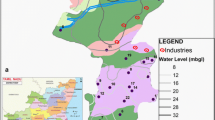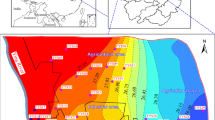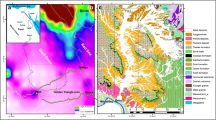Abstract
Hydro-geologically constrained groundwater (HGCG) zones have restricted water-holding capacity and low natural recharge rates, leading to reduced groundwater storage potential. These restrictions stem from unfavorable landform shapes and geological conditions that hinder the natural replenishment, flow, and storage of groundwater. Hypsometric analysis by assessing the area-elevation relationship, indicates geological stage and landform shape, thereby offering insights into groundwater storage. Thus, in this study, an innovative approach by combining machine learning (ML) algorithms with hypsometric analysis, in-situ precipitation data, and Depth to Water Level data for delineating HGCG zones is proposed. The methodology was tested over the Indian Himalayan River basins of the Indus, Ganga, Brahmaputra, and Barack. Following hypsometric analysis and derivation of hypsometric parameters (HP), sub-watersheds (SW) were clustered into mountainous, shallow (< 10 m below ground level, mbgl), and deep (> 10 mbgl) Depth to Water Level (DWL) zones using unsupervised and supervised ML algorithms of k-means clustering and linear discriminant analysis (LDA), respectively. Out of the 140 SWs analyzed, 41 were identified as mountainous, 70 were characterized by shallow DWL, and 29 were found to exhibit deep DWL, with a classification accuracy of 95%. The classified DWL layer, in conjunction with observed seasonal in-situ precipitation and depth to water level data, was further utilized to identify 8 SWs covering a total area of 148,015.80 sq. km (11.17%) as hydro-geologically constrained groundwater zones. This innovative methodology highlights the significance of ML algorithms for identifying such zones based on hypsometric analysis and underscores the importance of delineating these zones for sustainable groundwater extraction and utilization.
Graphical Abstract


















Similar content being viewed by others
Data availability
All datasets used in this study are open source. The sub-watershed-wise hypsometric data of the Indus, Ganga, Brahmaputra and Barak River Basins are available upon request from the corresponding authors. The relevant codes of hypsometric analysis, k-means clustering and Linear Discriminant Analysis has been uploaded to GitHub and can be accessed via the following link on reasonable request https://github.com/srijaroy/GEEHypso.git.
References
Ahmad A, Nair AM (2021) Landform evolution of Tharsis Montes and Olympus Mons of Mars: Insights from morphometric, hypsometric and chronologic evidences. J Earth Syst Sci 130(3):172
Ahmad I, Ahmad Z, Munir S, ur Rehman O, Ali, SR, Shabbir Y, (2018) Characterization of Upper Indus Basin based on DEM hypsometric analysis. The Nucleus 55(1):8–16
Ahmed F, Rao KS (2016) Hypsometric analysis of the Tuirini drainage basin: A geographic information system approach. Int J Geomat Geosci 6(3):1685–1695
Al-Fugara AK, Pourghasemi HR, Al-Shabeeb AR, Habib M, Al-Adamat R, Al-Amoush H, Collins AL (2020) A comparison of machine learning models for the mapping of groundwater spring potential. Environ Earth Sci 79:1–19
Allafta H, Opp C, Patra S (2020) Identification of groundwater potential zones using remote sensing and GIS techniques: a case study of the Shatt Al-Arab Basin. Remote Sens 13(1):112
Andermann C, Longuevergne L, Bonnet S, Crave A, Davy P, Gloaguen R (2012) Impact of transient groundwater storage on the discharge of Himalayan rivers. Nat Geosci 5(2):127–213
Arulbalaji P, Padmalal D, Sreelash K (2019) GIS and AHP techniques-based delineation of groundwater potential zones: a case study from southern Western Ghats India. Sci Rep 9(1):2082
Aslam RA, Shrestha S, Pandey VP (2018) Groundwater vulnerability to climate change: A review of the assessment methodology. Sci Total Environ 612:853–875
Central Ground Water Board (2019) Ground Water Yearbook, 2018–2019. Retrieved from http://cgwb.gov.in/documents/GW%20Year%20Book_2018-19_JAN%208.pdf on 16/7/2023
Central Ground Water Board (2022) Ground Water Resource Assessment report of 2022 (Report No GWRA 2022). Retrieved from http://cgwb.gov.in/documents/2022-11-11-GWRA%202022.pdf on 16/7/2023
Central Water Commission and National Remote Sensing Centre, Ministry of Jal Shakti, Government of India (2014a) Basin Report of Ganga Basin. Retrieved from https://indiawris.gov.in/downloads/Ganga%20Basin.pdf on 1/11/2023
Central Water Commission and National Remote Sensing Centre, Ministry of Jal Shakti, Government of India (2014b) Basin Report of Indus Basin. Retrieved from https://indiawris.gov.in/downloads/Indus%20Basin.pdf on 1/11/2023
Central Water Commission and National Remote Sensing Centre, Ministry of Jal Shakti, Government of India (2014c) Basin Report of Brahmaputra Basin. Retrieved from https://indiawris.gov.in/downloads/Brahamaputra%20Basin.pdf on 17/11/2023
Central Water Commission and National Remote Sensing Centre, Ministry of Jal Shakti, Government of India (2014d) Basin Report of Baraka and Others Basin. Retrieved from https://indiawris.gov.in/downloads/Barak%20and%20Others%20Basin.pdf on 17/11/2023
Chaudhry AK, Kumar K, Alam MA (2021) Mapping of groundwater potential zones using the fuzzy analytic hierarchy process and geospatial technique. Geocarto Int 36(20):2323–2344
Das B, Pal SC, Malik S, Chakrabortty R (2019) Modeling groundwater potential zones of Puruliya district, West Bengal, India using remote sensing and GIS techniques. Geol Ecol Landsc 3(3):223–237
DeCelles PG, Gehrels GE, Quade J, Ojha TP, Kapp PA, Upreti BN (1998) Neogene foreland basin deposits, erosional unroofing, and the kinematic history of the Himalayan fold-thrust belt, western Nepal. Geol Soc Am Bull 110(1):2–21
Elabanavi S, Lamani S (2019) Hypsometric analysis of the Malaprabha sub basin of Krishna River, Karnataka, India. Int J Res Appl Sci Eng Technol 7(7):846–850
Fisher RA (1936) The use of multiple measurements in taxonomic problems. Ann Eugen 7(2):179–188
Foster SB, Allen DM (2015) Groundwater—surface water interactions in a mountain-to-coast watershed: effects of climate change and human stressors. Adv Meteorol 2015:1–22
Frimpter MH, Fisher MN (1983) Estimating highest ground-water levels for construction and land use planning a Cape Cod Massachusetts example: US Geological Survey Water-Resources Investigations Report 83–4112
Garzanti E, Critelli S, Ingersoll RV (1996) Paleogeographic and paleotectonic evolution of the Himalayan Range as reflected by detrital modes of Tertiary sandstones and modern sands (Indus transect, India and Pakistan). Geol Soc Am Bull 108(6):631–642
Gopinath G, Nalukudiparambil J, Bhadran A, Girishbai D, Pillai SU (2022) Geomorphological analysis of tropical river basins in southern Kerala using hypsometric indices and neotectonic proxies. J Earth Syst Sci 131(4):246
Haile MM (2022) Approaches for delineating groundwater recharge potential zone using fuzzy logic model. Geofluids 2022
Halder S, Roy MB, Roy PK (2020) Fuzzy logic algorithm based analytic hierarchy process for delineation of groundwater potential zones in complex topography. Arab J Geosci 13:1–22
Harlin JM (1978) Statistical moments of the hypsometric curve and its density function. J Int Assoc Math Geol 10:59–72
Hartigan JA, Wong MA (1979) Algorithm AS 136: A k-means clustering algorithm. J R Stat Soc Ser C Appl Stat 28(1):100–108
Hurtrez JE, Sol C, Lucazeau F (1999) Effect of drainage area on hypsometry from an analysis of small-scale drainage basins in the Siwalik Hills (Central Nepal). Earth Surf Process Landforms: the Journal of the British Geomorphological Research Group 24(9):799–808
India-WRIS (2012) River Basin Atlas of India. RRSC-West, NRSC, ISRO, Jodhpur, India
Jain PK (1998) Remote sensing techniques to locate ground water potential zones in upper Urmil River Basin District Chhatarpur—Central India. J Indian Soc Remote Sens 26:135–147
Jain SK, Kumar V (2012) Trend analysis of rainfall and temperature data for India. Curr Sci 37–49
Kaiser HF (1959) Computer program for varimax rotation in factor analysis. Educ Psychol Measur 19(3):413–420
Khan HH, Khan A, Ahmed S, Gennero MC, Minh KD, Cazenave A (2013) Terrestrial water dynamics in the lower Ganges—estimates from ENVISAT and GRACE. Arab J Geosci 6:3693–3702
Khan A, Khan HH, Umar R, Khan MH (2014a) An integrated approach for aquifer vulnerability mapping using GIS and rough sets: Study from an alluvial aquifer in north India. Hydrogeol J 22(7):1561
Khan HH, Khan A, Sreedevi PD, Ahmed S (2014b) Mapping potential infiltration patterns using digital elevation model. J Geogr Inf Syst Article. https://doi.org/10.4236/jgis.2014.64031
Kumar P, Kumar D, Kashyap PS (2017) Hypsometric analysis of Mid-Himalayan watershed using geomatics. J Hill Agric 8(4):462–467
Kumar R, Dwivedi SB, Gaur S (2021) A comparative study of machine learning and Fuzzy-AHP technique to groundwater potential mapping in the data-scarce region. Comput Geosci 155:104855
Kumar MD, Shah T (2006) Groundwater pollution and contamination in India: the emerging challenge. IWMI-TATA Water Policy Program Draft Paper 2006/1
Lee S, Hyun Y, Lee S, Lee MJ (2020) Groundwater potential mapping using remote sensing and GIS-based machine learning techniques. Remote Sens 12(7):1200
Lehner B, Grill G (2013) Global river hydrography and network routing: baseline data and new approaches to study the world’s large river systems. Hydrol Process 27(15):2171–2186
Lehner B, Verdin K, Jarvis A (2008) New global hydrography derived from spaceborne elevation data. EOS Trans Am Geophys Union 89(10):93–94
Likas A, Vlassis N, Verbeek JJ (2003) The global k-means clustering algorithm. Pattern Recogn 36(2):451–461
Luo W (2000) Quantifying groundwater-sapping landforms with a hypsometric technique. J Geophys Res Planets 105(E1):1685–1694
Luo W (2002) Hypsometric analysis of Margaritifer Sinus and origin of valley networks. J Geophys Res Planets 107(E10):1–1
Markose VJ, Jayappa KS (2011) Hypsometric analysis of Kali River Basin, Karnataka, India, using geographic information system. Geocarto Int 26(7):553–568
Masoudian E, Pahlavani P (2023) Gis-Based Groundwater Potential Mapping Using Machine Learning Models, a Case Study: Qom Province Iran. ISPRS Ann Photogramm Remote Sens Spat Inf Sci 10:489–494
Meshram SG, Sharma SK (2017) Prioritization of watershed through morphometric parameters: a PCA-based approach. Appl Water Sci 7:1505–1519
Miller VC (1953) A quantitative geomorphic study of drainage basin characteristics in the Clinch Mountain area, Virginia and Tennessee, vol 3. Columbia University, New York
Mir S, Bhat MS, Rather GM, Mattoo D (2021) Groundwater Potential Zonation using Integration of Remote Sensing and AHP/ANP Approach in North Kashmir, Western Himalaya India. Remote Sens Land 5:41–58
Mukaka MM (2012) A guide to appropriate use of the correlation coefficient in medical research. Malawi Med J 24(3):69–71
Patra S, Mishra P, Mahapatra SC (2018) Delineation of groundwater potential zone for sustainable development: A case study from Ganga Alluvial Plain covering Hooghly district of India using remote sensing, geographic information system and analytic hierarchy process. J Clean Prod 172:2485–2502
Pearson K (1901) LIII. On lines and planes of closest fit to systems of points in space. London Edinb Dublin Philos Mag J Sci 2(11):559–572
Pérez-Peña JV, Azañón JM, Azor A (2009) CalHypso: An ArcGIS extension to calculate hypsometric curves and their statistical moments. Applications to drainage basin analysis in SE Spain. Comput Geosci 35(6):1214–1223
Pike RJ, Wilson SE (1971) Elevation-relief ratio, hypsometric integral, and geomorphic area-altitude analysis. Geol Soc Am Bull 82(4):1079–1084
Pourghasemi HR, Sadhasivam N, Yousefi S, Tavangar S, Nazarlou HG, Santosh M (2020) Using machine learning algorithms to map the groundwater recharge potential zones. J Environ Manage 265:110525
Prasad P, Loveson VJ, Kotha M, Yadav R (2020) Application of machine learning techniques in groundwater potential mapping along the west coast of India. GISci Remote Sens 57(6):735–752
Pujades E, Jurado A (2021) Groundwater-related aspects during the development of deep excavations below the water table: A short review. Underground Space 6(1):35–45
Radulović M, Brdar S, Mesaroš M, Lukić T, Savić S, Basarin B, Pavić D (2022) Assessment of Groundwater Potential Zones Using GIS and Fuzzy AHP Techniques—A Case Study of the Titel Municipality (Northern Serbia). ISPRS Int J Geo Inf 11(4):257
Rajendran CP, Rajendran K, Duarah BP, Baruah S, Earnest A (2004) Interpreting the style of faulting and paleoseismicity associated with the 1897 Shillong, northeast India, earthquake: Implications for regional tectonism. Tectonics 23(4)
Rather AF, Ahmed R, Wani GF, Ahmad ST, Dar T, Javaid S, Ahmed P (2022) Mapping of groundwater potential zones in Pohru Watershed of Jhelum Basin-Western Himalaya, India using an integrated approach of remote sensing, GIS, and AHP. Earth Sci Inf 15(4):2091–2107
Reddy GO, Mouli KC, Srivastav SK, Srinivas CV, Maji AK (2000) Evaluation of ground water potential zones using remote sensing data-A case study of Gaimukh watershed Bhandara District Maharashtra. J Indian Soc Remote Sens 28:19–32
Rousseeuw PJ (1987) Silhouettes: a graphical aid to the interpretation and validation of cluster analysis. J Comput Appl Math 20:53–65
Roy S, Chintalacheruvu MR (2023a) Assessing long-term changes in the lower Godavari River Basin using geo-spatial technology: an analysis of river bank erosion and accretion in sustainable lifestyle approaches towards environment and climate change, EIACP (PC- RP) Special Issues 2023 ISSN 0972–4656 MINENVIS Monograph 36–49
Roy S, Chintalacheruvu MR (2023b, February). LULC Dynamics Study and Modeling of Urban Land Expansion Using CA-ANN. In: International conference on science, technology and engineering. Springer Nature Singapore, Singapore, pp 79–90
Roy S, Chintalacheruvu MR (2023c) Google Earth Engine-based morphometric parameter evaluation and comparative analysis of soil erosion susceptibility using statistical and machine learning algorithms in large river basins. Earth Sci Inform 1–23. https://doi.org/10.1007/s12145-023-01133-1
Schindler TL, Rodell M (2014) Groundwater Depletion in India Revealed by GRACE -Extended, NASA/Goddard Space Flight Center Scientific Visualization Studio accessed from https://svs.gsfc.nasa.gov/4134/#section_credits on July 15, 2023
Schumm SA (1956) Evolution of drainage systems and slopes in badlands at Perth Amboy, New Jersey. Geol Soc Am Bull 67(5):597–646
Shahid S, Nath SK, Maksud Kamal AS (2002) GIS integration of remote sensing and topographic data using fuzzy logic for ground water assessment in Midnapur District India. Geocarto Int 17(3):69–74
Shamsudduha M, Panda DK (2019) Spatio-temporal changes in terrestrial water storage in the Himalayan River basins and risks to water security in the region: A review. Int J Disaster Risk Reduct 35:101068
Sharma SK, Tignath S, Gajbhiye S, Patil R (2013) Use of geographical information system in hypsometric analysis of Kanhiya Nala watershed. Int J Remote Sens Geosci 2(3):30–35
Shekar PR, Mathew A (2022) Evaluation of morphometric and hypsometric analysis of the Bagh River basin using remote sensing and geographic information system techniques. Energy Nexus 7:100104
Shekhar S, Pandey AC (2015) Delineation of groundwater potential zone in hard rock terrain of India using remote sensing, geographical information system (GIS) and analytic hierarchy process (AHP) techniques. Geocarto Int 30(4):402–421
Somers LD, McKenzie JM (2020) A review of groundwater in high mountain environments. Wiley Interdiscip Rev Water 7(6):e1475
Strahler AN (1952) Hypsometric (area-altitude) analysis of erosional topography. Geol Soc Am Bull 63(11):1117–1142
Subramani T, Moorthy KV, Priyanka S (2017) Assessment of Impact on Aquaculture Using Remote Sensing Data and GIS in Tiruchendur. Int J Emerg Trends Technol Comput Sci (IJETTCS) 6(3):157–166
Toll DG, Abedin Z, Buma J, Cui Y, Osman AS, Phoon KK (2012) The impact of changes in the water table and soil moisture on structural stability of buildings and foundation systems: systematic review CEE10–005 (SR90)
Watson DF (1985) A refinement of inverse distance weighted interpolation. Geo-Processing 2:315–327
Wold S, Esbensen K, Geladi P (1987) Principal component analysis. Chimometrics and intelligent laboratory systems. In: IEEE Conference on Emerging Technologies & Factory Automation Efta, pp. 704–706
World Health Organization (2017) Guidelines for drinking-water quality, 4th edition incorporating the first addendum. World Health Organization, Geneva, Switzerland
Funding
The authors have no relevant financial or non-financial interests to disclose.
Author information
Authors and Affiliations
Contributions
All authors contributed to the study's conception and design. Srija Roy performed material preparation, data collection, and analysis. The first draft of the manuscript was written by Srija Roy, and Madhusudana Rao Chintalacheruvu reviewed previous versions of the manuscript and made necessary corrections. All authors have read and approved the final manuscript.
Corresponding author
Ethics declarations
Competing interests
The authors declare no competing interests.
Additional information
Communicated by: H. Babaie
Publisher's note
Springer Nature remains neutral with regard to jurisdictional claims in published maps and institutional affiliations.
Rights and permissions
Springer Nature or its licensor (e.g. a society or other partner) holds exclusive rights to this article under a publishing agreement with the author(s) or other rightsholder(s); author self-archiving of the accepted manuscript version of this article is solely governed by the terms of such publishing agreement and applicable law.
About this article
Cite this article
Roy, S., Chintalacheruvu, M.R. Delineating hydro-geologically constrained groundwater zones in the Himalayan River basins of India through an innovative ensemble of hypsometric analysis and machine learning algorithms. Earth Sci Inform 17, 501–526 (2024). https://doi.org/10.1007/s12145-023-01177-3
Received:
Accepted:
Published:
Issue Date:
DOI: https://doi.org/10.1007/s12145-023-01177-3




